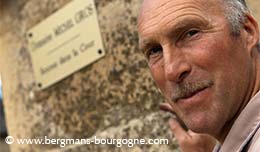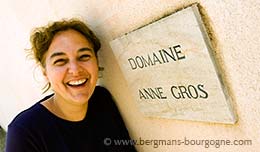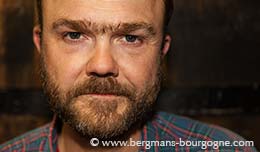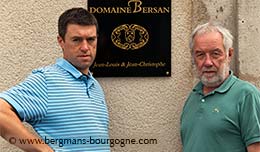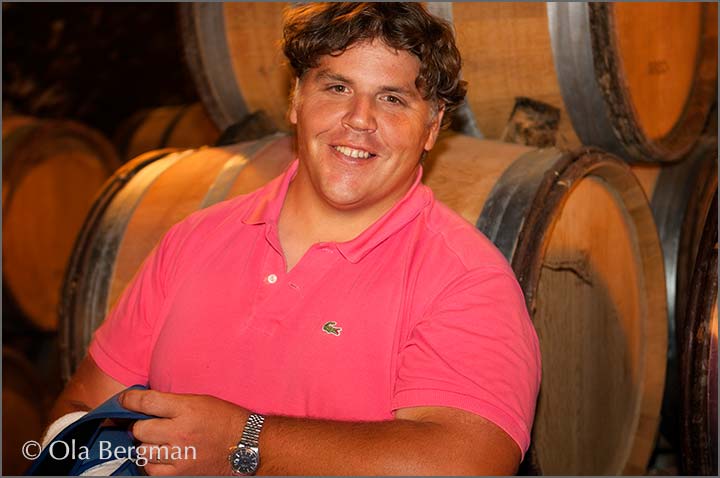
hibault Liger-Belair is in for the long run. After setting up his domaine in Nuits-Saint-Georges in 2001 he went organic right from the start and then fully biodynamic in 2005.
– We are not here for ourselves, he says. We are here for the future. We should try not to make too many mistakes while we are here.
There have been vineyards in the family for a long time. Close to three centuries. It was in 1720 that the négociant business was created. But Thibault Liger-Belair was the first one in the family to become a wine-grower.
 – In the past it would not have been possible for the son to become a wine-grower, explains Thibault Liger-Belair. It would have been like becoming a farmer, something that wasn’t really allowed.
– In the past it would not have been possible for the son to become a wine-grower, explains Thibault Liger-Belair. It would have been like becoming a farmer, something that wasn’t really allowed.
– In general, what would happen was that the father would tell the oldest son to become the chairman of the négociant company. The second son would be sent off to the army to become a general or something and the third son would become a priest. There wasn’t a choice.
Luckily for Thibault Liger-Belair things have changed. And even if the négociant business went under in the 1970’s the vineyards were still in the family, nice vineyards like Clos de Vougeot, Richebourg and Nuits-Saint-Georges premier cru Les Saint-Georges.
– It was not easy at the start. If you come from an old Burgundian family, a family considered as a noble family, which has never worked in the vineyards, there were people waiting to see what this kid born with a silver spoon in his mouth would be able to do with such fantastic vineyards. But there were many who were very helpful as well.
 Since then he has experienced a number of very different vintages. Thanks to the different characters of them he feels he has gained experience that normally require ten times as much time.
Since then he has experienced a number of very different vintages. Thanks to the different characters of them he feels he has gained experience that normally require ten times as much time.
Thibault Liger-Belair produces two different Hautes-Côtes de Nuits – Le Clos du Prieuré and La Corvée de Villy. Both are red and come from vines located up above Nuits-Saint-Georges on the Chaux plateau.
– I have decided to produce two cuvées of Hautes-Côtes de Nuits, he explains. It is my job to separate the terroirs. You can have two parcels within the same appellation, but with very different soil types. Like these two parcels.
– I am sure the Hautes-Côtes has a great potential for the future. It all depends on where you have your vines, but there are some very nice places above Nuits-Saint-Georges.
– Global warming has some impact, but there is also a new generation of growers in the Hautes-Côtes. They can’t afford to buy land on the Côte, so they move up in the Hautes-Côtes and they do a very good job there. They try to do things differently. They reduce their yields. They push the other growers to perform better.
 The straight Bourgogne rouge of Domaine Thibault Liger-Belair comes from a plot – Les Grands Chaillots – down-slope of Les Saint-Georges, on the other side of the Beaune-Dijon road. One step up, on village level, there are three wines – La Charmotte in Nuits-Saint-Georges, La Croix des Champs in Gevrey Chambertin and Aux Réas in Vosne-Romanée.
The straight Bourgogne rouge of Domaine Thibault Liger-Belair comes from a plot – Les Grands Chaillots – down-slope of Les Saint-Georges, on the other side of the Beaune-Dijon road. One step up, on village level, there are three wines – La Charmotte in Nuits-Saint-Georges, La Croix des Champs in Gevrey Chambertin and Aux Réas in Vosne-Romanée.
– La Charmotte is just north of Nuits-Saint-Georges, at the bottom of the slope, says Thibault Liger-Belair. It’s right next to the premier cru Bousselots. I bought this parcel in 2002. There is 30-40 centimetres of clay, then you have the limestone. In the wine, at first you have sweetness and elegance. Then, at the end, you have the freshness from the limestone. I use one third new barrels and two thirds three year old barrels. 20 per cent are whole clusters.
He explains that there is not a set recipe for the use of whole clusters at Domaine Thibault Liger-Belair. The decision is made in the vineyards, just before the harvest.
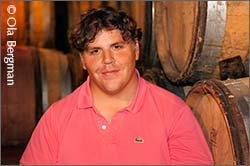 – We always harvest twice. The first time we select the best grapes, the ones to keep as whole clusters. The second time we pick all the other grapes. The amount of whole cluster varies between ten and 50 per cent.
– We always harvest twice. The first time we select the best grapes, the ones to keep as whole clusters. The second time we pick all the other grapes. The amount of whole cluster varies between ten and 50 per cent.
– What I like about the stems is that you have a lot of minerals in them – potassium, phosphorus, magnesium etc. This adds some aromatic freshness. In vineyards without much limestone this can be a way to get more freshness and better length. You might get a little less colour, but I never look for colour. I prefer to have good balance.
Domaine Thibault Liger-Belair is one of the few producers to bottle the Aloxe-Corton premier cru La Toppe au Vert.
– I have been buying the grapes since 2005. La Toppe au Vert is in Ladoix-Serrigny, just below Corton Vergennes. It is a parcel with a lot of limestone. Often in Aloxe-Corton you have wines with a lot of body and big tannins. For this one, this is absolutely not the case. It is not big-bodied. It is very different from the other wines you find in Aloxe-Corton. It is a very good terroir for making a wine with precision and finesse.
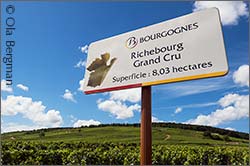 In Nuits-Saint-Georges Les Saint-Georges is the grand cru the village never got. Since 2007 Thibault Liger-Belair and the other twelve owners are in the process of trying to have reclassified as grand cru.
In Nuits-Saint-Georges Les Saint-Georges is the grand cru the village never got. Since 2007 Thibault Liger-Belair and the other twelve owners are in the process of trying to have reclassified as grand cru.
– It has always been regarded as hors classe, says Thibault Liger-Belair. Before the AOC system you had five levels of classification. Then five had to become three and changes were made. Les Saint-Georges did not make it into the grand cru category. Politics were involved. The only buyers were the négociants and they did not want many different cuvées. They were happy with Romanée-Conti, Richebourg etc. Les Saint-Georges was used to improve the quality of the other Nuits-Saint-Georges wines. Since then much has changed. We are just asking for an anomaly to be fixed.
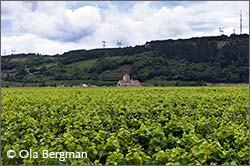 He is convinced they will succeed. When they do he doubts it will have much impact on the price. Les Saint-Georges is already higher priced than the other Nuits-Saint-Georges premier crus.
He is convinced they will succeed. When they do he doubts it will have much impact on the price. Les Saint-Georges is already higher priced than the other Nuits-Saint-Georges premier crus.
In 2007 Thibault Liger-Belair began buying land in the Beaujolais. Today he has almost eight hectares of vines, all in the Moulin-à-Vent appellation and producing four different cuvées.
– I’ve always been impressed by the Beaujolais, ever since I studied there in 1995 and 1996. I’ve never understood why the Beaujolais wines have been so criticised. So even if I created my domaine in Nuits-Saint-Georges I have always had this idea of starting something in the Beaujolais.
Having tasted many old Beaujolais bottles blind he is convinced that quality is on par with Burgundy. Bottles from 1934 or 1959 he has tasted have been on grand cru level. Buying vineyards, however, in the Beaujolais is considerably cheaper than in Burgundy. About one tenth of the price. While one hectare of Nuits-Saint-Georges costs between 800 000 and 1 000 000 euros one hectare Moulin-à-Vent is between 80 000 and 100 000 euros.
– I found a price list from the family business from 1911. The price of Morgon was exactly the same as Vosne-Romanée and Gevrey-Chambertin. So what has happened?
© 2013 Ola Bergman










